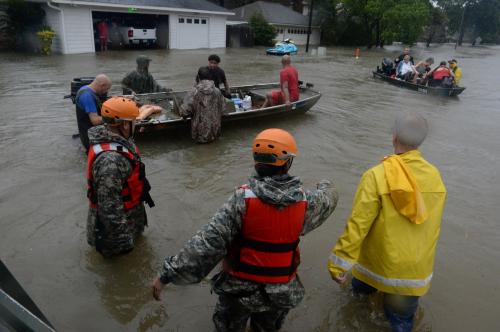This post is the first in a two part series about how procuring infrastructure systems, technologies, and services can be an entry point to resilience in cities, rather than an obstacle to it.
Many cities across the United States are home to legacy infrastructure systems. These older water, transportation, and communications systems are not only poorly suited to current needs, but they are also nearing (or well past) the end of their usable lives after decades of underinvestment and deferred maintenance.
The motivation for investing in resilience—taking measures to adapt and modernize systems amid rising environmental and social pressures—could not be greater, especially at a local level.
However, local government resources for infrastructure transformation are limited at best. As a result, local leaders are caught in a tug-of-war. On one side are high-priority incremental repairs to keep critical services up-and-running. On the other side is all the up-front planning required to invest in long-term capital projects. Both are costly. Both are necessary. In the coming years, more places will inevitably be confronted with a stark choice: keep making short-term fixes or find the resources to make major upgrades and replacements.
As grim as this decision can be from a budget perspective, it is also an opportunity. Cities across the U.S. have a once-in-a-generation chance to shift toward cleaner, greener technologies and build more resilient communities.
To seize this opportunity, cities must be able to buy things differently in order to buy different things. And that’s where procurement processes can be a hurdle to achieving greater resilience.
The term procurement encompasses all the steps that governments or public authorities take to obtain goods, such as computers or desks, or services like healthcare or construction of a water treatment plant. Most existing procurement processes make it easiest for government agencies to buy what they already have, provided by companies they’ve already worked with before. This bias toward the familiar can keep decisionmakers trapped in a “pieces-and-parts” replacement approach. This is true, even when more cost-effective upgrades, replacements, or wholesale transformations are readily available.
Picture the difference between replacing failing water mains and transitioning to city-wide green infrastructure solutions. The process for buying pipes and repair services is a well-trodden path, but figuring out how to buy and maintain thousands of street trees or miles of porous pavement is often uncharted territory.
The unfortunate consequence of this type of procurement “lock-in” is two-fold. Every day, cities miss opportunities to leapfrog to smarter, more sustainable, and more resilient infrastructure. And innovative companies and urban solutions simultaneously struggle to scale. This is a solvable problem, but pouring money into developing new technologies or better plans doesn’t necessarily lead to project implementation or better outcomes.
Investing in better procurement processes up front can enable better outcomes, but knowing when and how to shift from the incremental to the transformational is an enormous challenge for cities of every size. Bigger cities often have more resources and expertise to dedicate to long-term planning for these transitions. But even smaller cities with fewer resources need the tools to design, procure, and build entirely new types of infrastructure solutions to make progress on big picture goals, including improving water and resource-efficiency, building resilience to climate change, and advancing social equity.
In recent years, several cities and counties have begun to experiment with how procurement can enable better outcomes.
One of the most compelling examples in the water sector is the Prince George’s County Clean Water Partnership in Maryland. Rather than relying on a traditional procurement approach to address its stormwater challenges, the County pursued a 30-year public-private partnership. As part of a performance-based contract—with the aim to deliver more extensive green infrastructure—the County worked with Corvias, an engineering firm, to improve stormwater management and build a more equitable and diverse local workforce for project implementation. In other words, the County did not simply request proposals from potential vendors to get the project done, but it instead looked to break free from this traditional process and engage more directly with Corvias to aim for improved performance overall. And so far, nearly three years later, the County has met or exceeded all of its economic, social, and environmental objectives on time and under budget.
The Clean Water Partnership is a shining example of how procurement innovation can allow local governments to tap into new ideas, new partners, and new resources. But clearly, not all places have been able to pursue the same types of innovations—or realize more resilient outcomes. Investing in better procurement processes up front can enable better outcomes for taxpayers, residents, and businesses alike in cities across the United States. Moving forward, local leaders need to stop thinking about procurement as the end point of a process, and start looking at procurement as an entry point to spark new ideas, attract new partners, and generate new resources.
The Brookings Institution is committed to quality, independence, and impact.
We are supported by a diverse array of funders. In line with our values and policies, each Brookings publication represents the sole views of its author(s).








Commentary
Investing in better procurement processes can enable better infrastructure outcomes
November 26, 2018